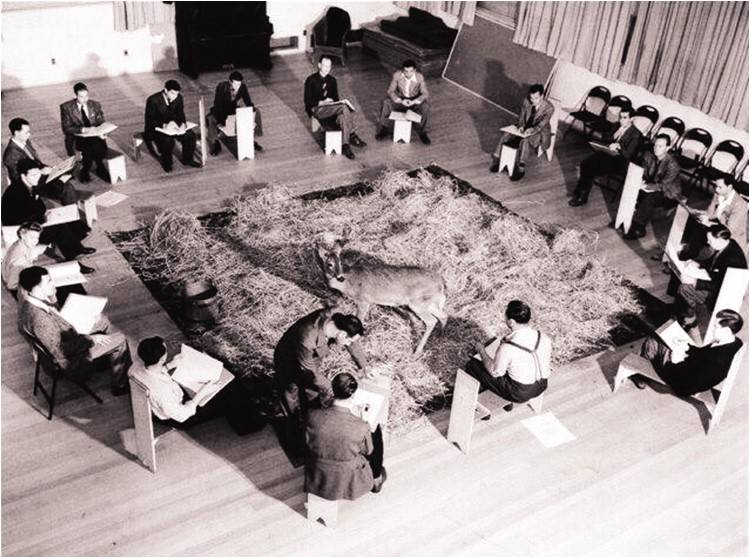
This photograph shows artists studying a deer for the making of Bambi, which premiered in New York on August 13, 1942. This was the fifth feature film released by Walt Disney and his team of imaginative collaborators. It was the last animated feature film that would be produced by the studio for almost a decade; the period of World War II resulted in Walt releasing “package films” that were easier to manage.
Some animators on the Bambi team went to the woods to observe the actual animals, while other times deer were brought into the studio. A stylistic breakthrough occurred when a young artist named Ty Wong submitted drawings for Bambi. He did this on his own accord, and when Walt saw the drawings, it became the basis for the style for the film. Suggestive rather than highly realistic, Wong’s design provided a visual breakthrough for the artists. Because of the prolonged production of Pinocchio, the Bambi team was given more time to conceptualize and refine the characters and story.
Four more months were spent concentrating on drawing deer. Walt hired a nature photographer, Maurice Day to shoot new footage in Maine and sent the production photos of the woods in different weather conditions and seasons. The animators painstakingly studied dear anatomy, making sure everything was just right. The story shifted too, with animator Ham Luske suggesting that a bunny be a guide and friend to Bambi, leading to a much larger role for Thumper.
During Bambi’s production, the company relocated to Burbank, and its crew was one of the first in the new Animation Building. With Pinocchio now finished, Walt was able to focus more time on Bambi. He knew that the story required more subtlety and that it didn’t have as much of an arc as some of the more dramatic fairy-tale fare they had been working on. At one point, Walt suggested that they make the film longer and present it as a “roadshow” feature with limited performances.
Some animators on the Bambi team went to the woods to observe the actual animals, while other times deer were brought into the studio. A stylistic breakthrough occurred when a young artist named Ty Wong submitted drawings for Bambi. He did this on his own accord, and when Walt saw the drawings, it became the basis for the style for the film. Suggestive rather than highly realistic, Wong’s design provided a visual breakthrough for the artists. Because of the prolonged production of Pinocchio, the Bambi team was given more time to conceptualize and refine the characters and story.
Four more months were spent concentrating on drawing deer. Walt hired a nature photographer, Maurice Day to shoot new footage in Maine and sent the production photos of the woods in different weather conditions and seasons. The animators painstakingly studied dear anatomy, making sure everything was just right. The story shifted too, with animator Ham Luske suggesting that a bunny be a guide and friend to Bambi, leading to a much larger role for Thumper.
During Bambi’s production, the company relocated to Burbank, and its crew was one of the first in the new Animation Building. With Pinocchio now finished, Walt was able to focus more time on Bambi. He knew that the story required more subtlety and that it didn’t have as much of an arc as some of the more dramatic fairy-tale fare they had been working on. At one point, Walt suggested that they make the film longer and present it as a “roadshow” feature with limited performances.

